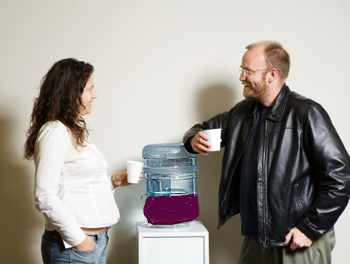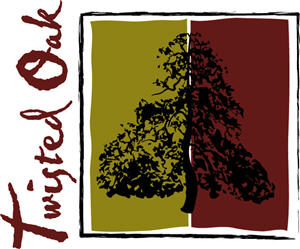

"I see Twitter as this massive world-wide water cooler,” he begins – an analogy that sets me bobbing my head in agreement, “and so I just like to have conversations there. The randomness is kind of the appeal."
~ Jeff Stai, Twisted Oak Winery
Wine Twittering: Welcome to the Virtual Water Cooler
To Tweet or Not to Tweet,
That Is the Question
by
Courtney Cochran
April 15, 2009
 he other day, while multitasking on three different projects with looming deadlines, I felt the uncontrollable urge to Tweet. And so instead of squashing the urge to deviate from my pressing (not to mention paying) workload, I mumbled something to myself about connectivity being good for business and logged on to Twitter.com. Within seconds I was typing a quick message (140 characters max, natch) to inform the 150 or so people who “follow” me on the site about what, precisely, I was doing or thinking at that very moment.
he other day, while multitasking on three different projects with looming deadlines, I felt the uncontrollable urge to Tweet. And so instead of squashing the urge to deviate from my pressing (not to mention paying) workload, I mumbled something to myself about connectivity being good for business and logged on to Twitter.com. Within seconds I was typing a quick message (140 characters max, natch) to inform the 150 or so people who “follow” me on the site about what, precisely, I was doing or thinking at that very moment.
Hopefully these folks also realize, thanks to the post, that I am far more than just an elusive journalist: I am also a real person, subject to error and neuroses and the occasional episode of “procrasturbation.” This (I hope), makes me more interesting, and the product I will eventually produce more compelling to them all.
At least, that was the inner monologue I was telling myself when I hit “post,” and I’m sticking to it.
The Wine Connection
Winemakers, it turns out, aren’t so different from journalists. They, too, benefit from the demystifying benefits of the Web’s latest social tools, including Twitter. Here are few facts to back this up:Fact: Wine is a substance that’s inextricably tied to the soil, to the hands that create it, to the place where it's made. You might call it authenticity bottled: When you sip it, you taste its truth, its provenance. This is a very good thing.
Fact: Wine is a substance that is at once obtainable and elusive; you can pour it from the bottle and drink it up, but you’re often thousands of miles from where it was produced and will probably never meet its maker. In this sense, wine can be distant, mysterious and foreign. This can be very frustrating.
Fact: Winemakers who can connect with tasters more often and in more intimate ways (no, not like that) will go far towards bridging this gap between what’s in the bottle (i.e. wine’s innate authenticity) and the other stuff
 drinkers want to know about a wine: its story as well as that of its maker, the parent who – for all intents and purposes – gave life to said beguiling vintage.
drinkers want to know about a wine: its story as well as that of its maker, the parent who – for all intents and purposes – gave life to said beguiling vintage.
In other words, today’s drinkers want to better understand the everyday, the mundane (which might even include something like a propensity towards procrasturbation – hey why not?) and the back story behind a wine far more than they want to hear the hyper-polished jargon that marketing execs create for a bottle’s back label. In a word: what they want is reality, and it turns out that today’s social networking tools – chief among them Twitter – deliver reality in spades.
So long, that is, as you can package your reality in blurbs of 140 characters or less.
It’s Twitterific
According to comScore, unique users on Twitter jumped to nearly 9.8 million in February from some 6.1 million in January, and this explosive growth includes (surprise!) a growing number of winemakers, marketers, retailers, sommeliers and drinkers.
million in February from some 6.1 million in January, and this explosive growth includes (surprise!) a growing number of winemakers, marketers, retailers, sommeliers and drinkers.
Folks who’ve begun using the free messaging service in an effort – conscious or not – to bridge this authenticity gap in the wine world. And while this impressive growth – coupled with the widely held theory that social networking is the most authentic form of marketing communication out there today – is certainly compelling, there are plenty of doubts as to whether or not it actually pays to bridge this divide, and thus become – ahem – more intimately in touch with customers.
And so, in an effort to better understand if the Twitter reality is measuring up to the hype where wine is concerned, I decided to get in touch with one of the wine world’s top Tweeters, Jeff Stai, owner of Twisted Oak Winery in Calaveras County, to see what he has to say on the matter.
Power to the Tweeple
As it happens, I catch Jeff on his birthday. When we connect, he is still reeling from the news that two members of his wine club – who joined after meeting him on WineWoot.com, another social site – have just informed him that they’ll be uncorking bottles of Twisted Oak wine to celebrate his big day. (How’s that for becoming better in touch with the people?)
social site – have just informed him that they’ll be uncorking bottles of Twisted Oak wine to celebrate his big day. (How’s that for becoming better in touch with the people?)
When I ask him if Twitter has helped his business, he admits that he’s sold wine, found new customers and even signed up new wine club members exclusively through the site. What’s more, he and his wife recently had dinner with a couple – fans of Twisted Oak wines, naturally – that he met on Twitter and who made a side trip to the Sierra Foothills while visiting from Texas expressly to meet him and to see where his wines are brought to life.
Not bad for a winery located in a region that’s hardly a hotbed for vinous tourism. And yet with 1,481 Twitter followers and more coming on board each day, Jeff looks poised to continue to grow his network – and no doubt special connections such as these along the way.
But the greatest benefit to all of this, as Jeff sees it, is the way that Twitter and other social networking sites allow winemakers to be themselves. “At this point in history,” he says, “you have to be you. People are looking for people to be people.” Moreover, Jeff recognizes that people like to talk. "I see Twitter as this massive world-wide water cooler,” he begins – an analogy that sets me bobbing my head in agreement, “and so I just like to have conversations there. The randomness is kind of the appeal."
Even if you’re just writing about procrastubation? I ask. With a laugh, Jeff concedes, “Probably 90 percent of what I put into my tweets is nonsense. But it creates a picture of a person, and this authenticity allows people who don’t know me to feel like they do.”
Apparently so much so that some even feel compelled to uncork a bottle of his very own wine on his birthday, and drink a toast to a producer who may in fact be thousands of miles away, but who feels as though he’s right there with them. For these customers, at least, the gap between what’s in the glass and where it comes from has closed.
Find Jeff on:
Blog
 READER FEEDBACK: To post your comments on this story,
click here
READER FEEDBACK: To post your comments on this story,
click here
Print this article | Email this article | More about America | More from Courtney Cochran













